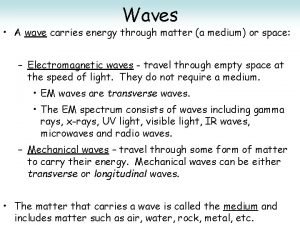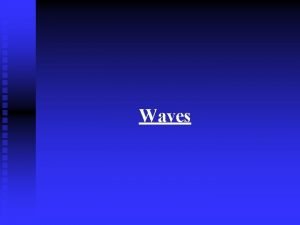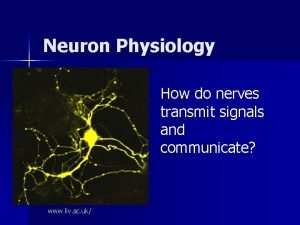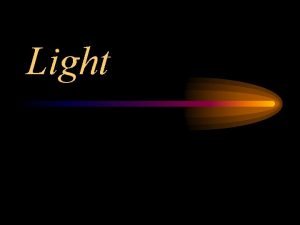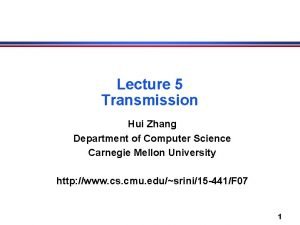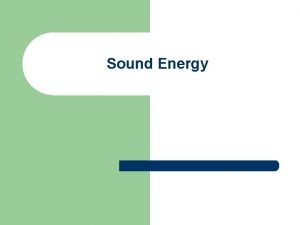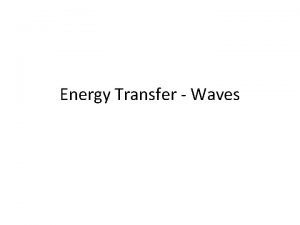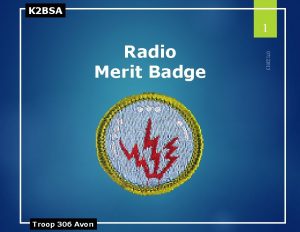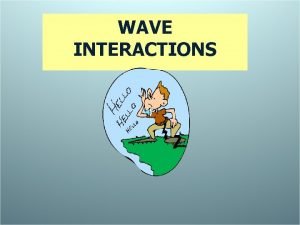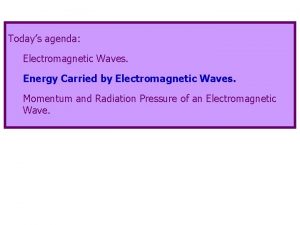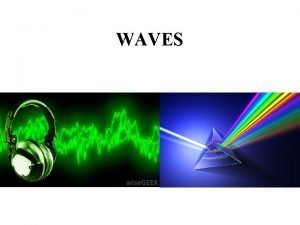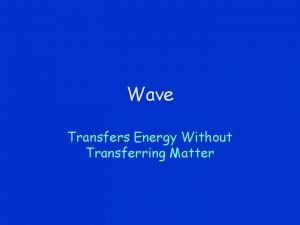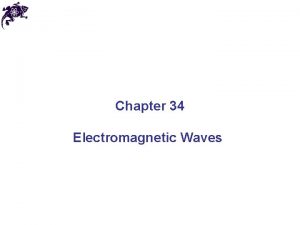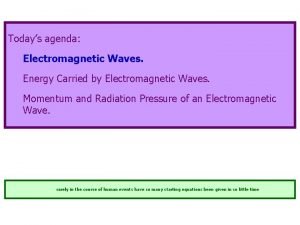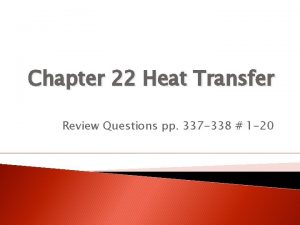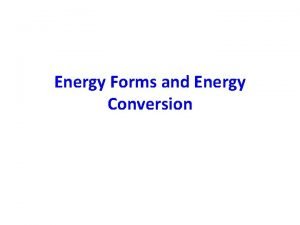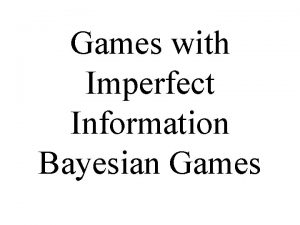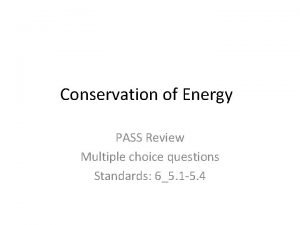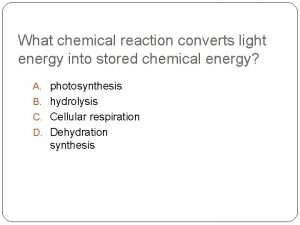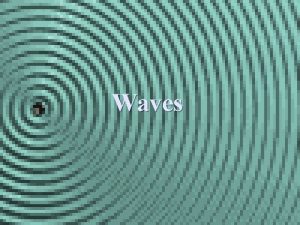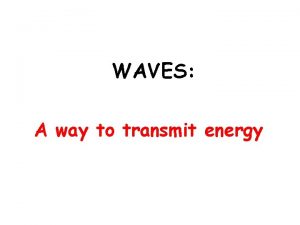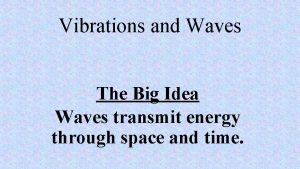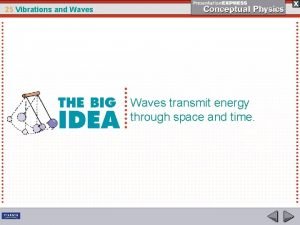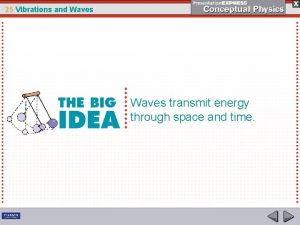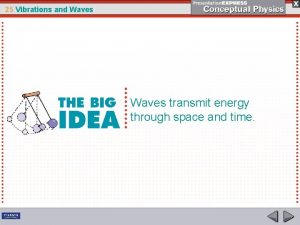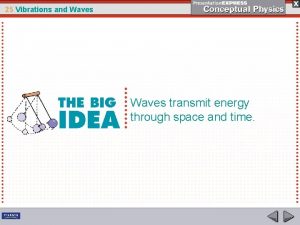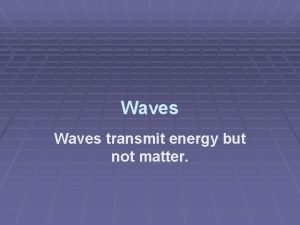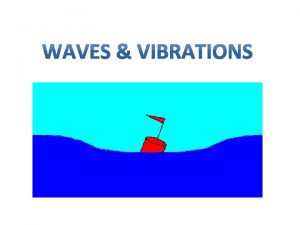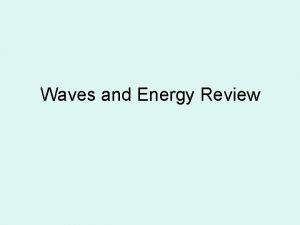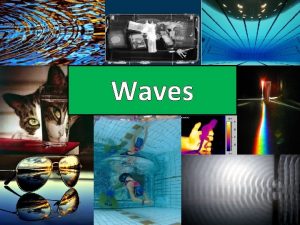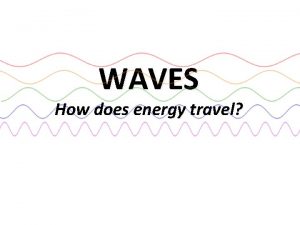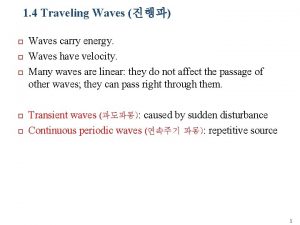Waves Waves n Waves transmit energy and information




































































- Slides: 68

Waves

Waves n Waves transmit energy and information. n Sound and Light are both waves.

There are two ways to transmit information/energy in our universe: Particle Motion and Wave Motion

1. VIBRATION OF A PENDULUM n Demo -Ball pendulum n What does the period (T) depend upon? Length of the pendulum (l). n Acceleration due to gravity (g). n Period does not depend upon the bob mass. n

When oscillations are small, the motion is called simple harmonic motion (shm) and can be described by a simple sine curve.

Sine Curve Wavelength Amplitude A

2. WAVE DESCRIPTION Picture of a Transverse Wave Crest Wavelength A A - Amplitude Trough

Wavelength ( ) n Distance between adjacent crests in a transverse wave n Distance a wave travels during one vibration n Units - meters or feet

Period (T) n Time required to make one vibration. n Time required to generate one wave. n Time required for the wave to travel one wavelength.

Frequency (f) The number of vibrations per unit of time made by the vibrating source. Units cycles per second 1/s Hertz (Hz)

Examples of Frequency n What is the frequency of the second hand of a clock? Frequency = 1 cycle/60 sec Period = 60 sec n What is the frequency of US Presidential elections? Frequency = 1 election/4 yrs Period = 4 yrs

Frequency Period

3. WAVE MOTION n Energy is transported by particles or waves. n A wave is a disturbance transmitted through a medium. n Exception: light does not require a medium.

Demo - Waves on a rope A disturbance moves through the medium. Elements of the medium vibrate. Examples: ripples on water wheat waves

4. WAVE SPEED The average speed is defined as

For a wave, if the distance traveled is a wavelength ( ), then the time to travel this distance is the period (T). Thus or

is true for all waves. Note: v is dictated by the medium. f is dictated by the source.

5. TRANSVERSE WAVES Particles vibrate perpendicular to the motion of the waves Slinky Transverse Waves string musical instruments ripples on water Examples: electromagnetic waves e. g. Light waves. Seismic “S”-waves.

Picture of a Transverse Wave Crest Wavelength A A - Amplitude Trough

6. LONGITUDINAL WAVES Particles vibrate Parallel to the motion of the waves - Slinky Longitudinal Waves e. g. Sound. Seismic P-waves.

Parameters Rarefactions are regions of low density. Compressions (condensations) are regions of high density. is the distance between…. . . …………. successive rarefactions or …………. successive compressions.

Demo - Slinky

7. Super position INTERFERENCE Superposition of Waves Overhead - Interference

Superposition A number of different waves can add, constructively or destructively. n The superposition of two or more waves results in interference.

Interference The superposition of two or more waves results in interference. n

Interference Pattern The pattern formed by superposition of different sets of waves that produce mutual n reinforcement in some places and cancellation in others.





Destructive Interference: Exactly out of Phase Cancellation + Zero displacement

Destructive interference occurs when waves are out of phase, that is when crests are superimposed with troughs.

Constructive Interference: Reinforcement + Maximum In phase displacement

Constructive Interference occurs when waves are in phase, that is when crests are superimposed and troughs are superimposed.

Constructive and Destructive Interference www. phy. ntnu. edu. tw/j ava/wave. Interference/w ave. Interference. html

Interference is a characteristic of all waves.

Standing Waves n When two sets of waves of equal amplitude and wavelength pass through each other in opposite directions, it is possible to create an interference pattern that looks like a wave that is “standing still. ” Demo - Rope and strobe n Demo - Mechanical overhead model n

Standing Wave V Incident Wave V Reflected Wave V Standing Wave V

Standing Waves

n There is maximum vibration at an antinode. n is twice the distance between successive nodes or successive antinodes. n There is no vibration at a node.

Notes on Standing Waves n There is no vibration at a node. n There is maximum vibration at an antinode. n is twice the distance between successive nodes or successive antinodes.

n Demo- Soda straw wave machine n Demo - tuning fork n Another example: musical instruments n Demo- Drumhead Vibrations

8. DOPPLER EFFECT n Refers to the change in frequency when there is relative motion between an observer of waves and the source of the waves n Doppler with Sound n www. physics. sfasu. e du/markworth/doppler. htm

Doppler Effect The shift in received frequency due to motion of a vibrating source toward or away from a n receiver.

Doppler Effect Notes Motion of Source and Observer Moving together Moving Apart Sound Light Higher Pitch Lower Pitch “Blue Shift” “Red Shift”

Doppler Shift Gives Radial Velocity True Velocity Radial Velocity Tangential Velocity Radar


Red Shift Lab Absorption Spectrum of Element X Red Shifted Star Absorption Spectrum of Element X Star is moving away from us.

Bow Wave The V-shaped wave made by an object moving across a liquid surface at a speed greater than n the wave speed. (Since the source is moving faster than the wave speed, the wavefronts pile up. )

9. BOW WAVES n Waves in front of moving object pile up. n Demo - Barrier slide n Demo - “Bow” wave slide

Shock Wave The cone-shaped wave made by an object moving at supersonic speed through a fluid. n (Here, the source is moving faster than the wave speed, which is the speed of sound!!) (Super-sonic speed)

10. SHOCK WAVES n Demo - Cone of Waves n There are two booms, one from the front of the flying object and one from the back.

Shock Wave

Sonic Boom The loud sound resulting from the incidence of a shock wave. (This n is the result of the pile up of many wave fronts which produces a sonic boom)

Sonic Boom Piled up wave n fronts produce a shock wave Plane

Shock Wave

Sonic booms from a plane are produced (a) because the plane breaks through the sound barrier (b) when the plane reaches the speed of sound (c) by the plane traveling faster than the speed of sound (d) by the plane traveling slower than the speed of sound

Twice the speed of sound Mach 2 Wave front n 1 unit Plane 2 units

n Demo - Crack whip n Wav File - Sonic Boom n The boom is not produced just when the flying object “breaks” through the sound barrier.

n. Subsonic - slower than the speed of sound n Supersonic - faster than the speed of sound speed of object n Mach Number = speed of sound

Review Questions

Doubling the mass of a simple pendulum undergoing small oscillations does what to the period of the pendulum? (a) cuts it in half (b) increases it by the square of 2 (c) nothing (d) doubles it

What dictates the frequency of a sound wave? (a) wavelength (b) medium (c) source of the sound (d) speed (e) amplitude

What determines the speed of a wave? (a) the frequency (b) the wavelength (c) the amplitude (d) the period (e) the medium of transmission

A skipper on a boat notices wave crests passing his anchor chain every 5 seconds. If the wave crests are 15 m apart, what is the speed of the water waves in m/s? (a) 5 (d) 10 (b) 15 (e) 3 (c) 75

For a medium transmitting a longitudinal wave, the areas of the medium where the density of the medium is temporarily increased are called. . . (a) rarefactions (b) compressions (c) density holes

When you move away from a fixed source of sound, the frequency of the sound you hear. . . (a) is greater than what the source emits (b) is less than what the source emits (c) is the same as what the source emits

Sonic booms from a plane are produced. . . (a) because the plane breaks through the sound barrier. (b) when the plane reaches the speed of sound. (c) by the plane traveling faster than the speed of sound. (d) by the plane traveling slower than the speed of sound.
 Waves that transmit energy through matter or empty space
Waves that transmit energy through matter or empty space Transmit waves
Transmit waves Mechanical waves and electromagnetic waves
Mechanical waves and electromagnetic waves Store and transmit genetic information
Store and transmit genetic information Introduction to the giver
Introduction to the giver Transmit diversity in lte
Transmit diversity in lte Neuron physiology
Neuron physiology Ce este un dialog
Ce este un dialog Automatic transmit power control
Automatic transmit power control Transmit light
Transmit light Hui transmit data
Hui transmit data Energy energy transfer and general energy analysis
Energy energy transfer and general energy analysis Energy energy transfer and general energy analysis
Energy energy transfer and general energy analysis Compare and contrast p waves and s waves using venn diagram
Compare and contrast p waves and s waves using venn diagram Differences between mechanical and electromagnetic waves
Differences between mechanical and electromagnetic waves Examples of mechanical waves
Examples of mechanical waves How are rainbows made
How are rainbows made Short wave vs long wave radiation
Short wave vs long wave radiation Mechanical waves and electromagnetic waves similarities
Mechanical waves and electromagnetic waves similarities Mechanical waves and electromagnetic waves similarities
Mechanical waves and electromagnetic waves similarities Surface waves and body waves
Surface waves and body waves Aimtoknow
Aimtoknow Light is electromagnetic wave true or false
Light is electromagnetic wave true or false What type of waves are sound waves? *
What type of waves are sound waves? * Sound is a longitudinal wave
Sound is a longitudinal wave Examples of mechanical and electromagnetic waves
Examples of mechanical and electromagnetic waves Seismic waves are mechanical waves
Seismic waves are mechanical waves What is sound
What is sound Kesler science
Kesler science Waves energy transfer
Waves energy transfer How radio waves carry information
How radio waves carry information Wave transfer matter
Wave transfer matter Energy density in em waves
Energy density in em waves Rate of energy transfer by sinusoidal waves on strings
Rate of energy transfer by sinusoidal waves on strings What is a repeating disturbance
What is a repeating disturbance Wave transfers
Wave transfers Electromagnetic waves obey principle of .. *
Electromagnetic waves obey principle of .. * Energy carried by electromagnetic waves
Energy carried by electromagnetic waves Do light waves transfer energy
Do light waves transfer energy Solar radiant energy is composed of short waves
Solar radiant energy is composed of short waves Section 2 describing energy
Section 2 describing energy Primary energy and secondary energy
Primary energy and secondary energy Hypdro
Hypdro Helmholtz free energy
Helmholtz free energy Renewable energy and energy efficiency partnership
Renewable energy and energy efficiency partnership Kinetic energy examples
Kinetic energy examples Conservation of mechanical energy
Conservation of mechanical energy Potential energy
Potential energy Kinetic energy and potential energy formula
Kinetic energy and potential energy formula Energy forms and energy conversions
Energy forms and energy conversions Imperfect information vs incomplete information
Imperfect information vs incomplete information Ceii ferc
Ceii ferc Energy information administration
Energy information administration Spring potential energy
Spring potential energy Gibbs free energy non standard conditions
Gibbs free energy non standard conditions Standard free energy change
Standard free energy change Efficiency formula
Efficiency formula Thermal energy vs heat energy
Thermal energy vs heat energy A hairdryer converts ____ energy into ____ energy.
A hairdryer converts ____ energy into ____ energy. Practical electricity formulas
Practical electricity formulas How to convert mechanical energy to electrical energy
How to convert mechanical energy to electrical energy Thermal energy section 3 using thermal energy
Thermal energy section 3 using thermal energy How to find delta g
How to find delta g As nutritional energy passes through the food chain it is
As nutritional energy passes through the food chain it is Usable chemical energy in food begins as __________ energy.
Usable chemical energy in food begins as __________ energy. Chapter 7 energy conservation of energy
Chapter 7 energy conservation of energy Wind energy is an indirect form of solar energy
Wind energy is an indirect form of solar energy ________ converts light energy into chemical energy. *
________ converts light energy into chemical energy. * Formula of potential and kinetic energy
Formula of potential and kinetic energy
